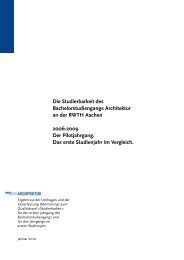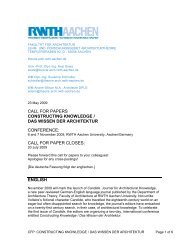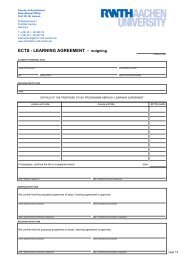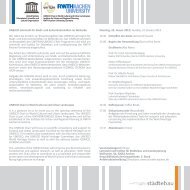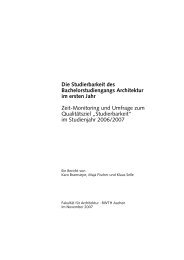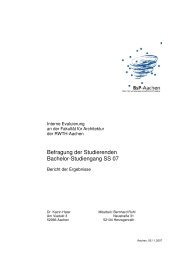Gutachten Dresden_englisch_dritte f.indd - Fakultät für Architektur ...
Gutachten Dresden_englisch_dritte f.indd - Fakultät für Architektur ...
Gutachten Dresden_englisch_dritte f.indd - Fakultät für Architektur ...
Create successful ePaper yourself
Turn your PDF publications into a flip-book with our unique Google optimized e-Paper software.
8<br />
Elbe Valley will be changed by the construction of the planned “Verkehrszug<br />
Waldschlösschenbrücke”.<br />
d. Visual and technical analysis of the “Verkehrszug Waldschlösschenbrücke”<br />
(Chapter 5)<br />
This chapter describes the “Verkehrszug Waldschlösschenbrücke” itself – its planning<br />
history, geographical location, dimensions and scale, design, technology and<br />
construction requirements. This is supplemented with an examination of the existing<br />
bridges in the <strong>Dresden</strong> Elbe Valley. Their scale and distinguishing features are described<br />
alongside their typology. This supplementary examination serves to provide a context<br />
within which the planned “Verkehrszug Waldschlösschenbrücke” can be compared in<br />
terms of the design and dimensions of the current <strong>Dresden</strong> Elbe Valley bridges.<br />
e. Field-of-view analyses<br />
(Chapter 6)<br />
A number of vantage points for analysing relevant fields of view were identified within<br />
the study area based on the study team’s on-location explorations by car and on foot.<br />
The identified viewing points were then compared to the study’s previously conducted<br />
research, and upon verification used as the source locations to take the photographs<br />
for the required field-of-view analyses. These photographs form the basis for a truthful<br />
simulation of the planned bridge project and a realistic comparison between the current<br />
and planned topography of the area. After the scientific generation of the field-of-view<br />
analyses, the evaluation of these represents the most important part of the study; it<br />
is the primary basis for assessing the visual impact of the planned bridge construction<br />
project.<br />
1.4 Conditions of the study<br />
Due to political and legal circumstances, the time span allotted to the visual impact<br />
study had to be very short. The study was commissioned on 9 February 2006 and had<br />
to be completed by 15 March 2006. As this was a very tight deadline, the authors<br />
had to limit their analyses to aspects that were directly relevant to the visual impact<br />
study. On the one hand, this approach displays a strong focus towards producing the<br />
required field-of-view analyses for the locations selected; on the other, it also provides<br />
an overview of the many-layered nature of this issue and the complexity of the planned<br />
construction project.






